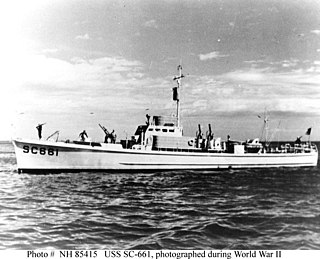
The Royal Norwegian Navy is the branch of the Norwegian Armed Forces responsible for naval operations of Norway. As of 2008, the RNoN consists of approximately 3,700 personnel and 70 vessels, including 4 heavy frigates, 6 submarines, 14 patrol boats, 4 minesweepers, 4 minehunters, 1 mine detection vessel, 4 support vessels and 2 training vessels. It also includes the Coast Guard.

The first USS Yarnall (DD–143) was a Wickes-class destroyer in the United States Navy during World War I later transferred to the Royal Navy as HMS Lincoln, to the Royal Norwegian Navy as HNoMS Lincoln, and subsequently to the Soviet Navy as Druzhny.

The first USS Hopewell (DD–181) was a Wickes-class destroyer in the United States Navy, entering service in 1919. After a brief active life, the ship was deactivated in 1922 and placed in reserve for 18 years before returning to service in 1940 during World War II. She was later transferred to the Royal Navy as HMS Bath (I17), as a Town-class destroyer, and then to the Royal Norwegian Navy as HNoMS Bath. Bath was torpedoed while escorting a trans-Atlantic convoy on 19 August 1941.
HMS P41 was a Royal Navy U-class submarine built by Vickers-Armstrong. She was transferred to the exiled Royal Norwegian Navy before completion and renamed HNoMS Uredd. She and one of the B-class in 1940 have so far been the only Norwegian submarine to have been sunk.

The Royal Norwegian Navy Museum is a museum documenting the history of the Royal Norwegian Navy. It is located at the former main naval base of Karljohansvern in Horten. The museum was founded by C.F. Klinck on 24 August 1853. The museum is sometimes regarded as the world's first naval museum, as it was the first collection of naval memorabilia open to the public.
The minelayer HNoMS Glommen was built for the Royal Norwegian Navy during World War I, as the lead ship of the two ship Glommen class of mine layers. Her sister ship was Laugen. Glommen and her sister ship were kept in service until the German invasion of Norway in 1940. Glommen surrendered to the Germans on 14 April 1940, and was rebuilt as a floating anti-aircraft battery. She was scuttled at Kirkenes in 1944 by the retreating Germans.

HMS Bangor was a Bangor-class minesweeper of the Royal Navy that served during the Second World War. She was built at the Harland and Wolff shipyard in Govan, Scotland. Bangor was the lead vessel of her class and one of the diesel-engined versions. She was ordered on 12 July 1939, laid down on 19 September 1939, launched on 23 May 1940, and commissioned on 7 November 1940.

HNoMS Otra was an Otra-class minesweeper built in 1939 for the Royal Norwegian Navy. Captured by the Germans during the 1940 invasion of Norway and renamed Togo, she was returned to the Norwegians in 1946. Otra remained in service until being sold for scrapping in 1963.

The Auk class were Allied minesweepers serving with the United States Navy and the British Royal Navy during the Second World War. In total, there were 95 Auks built.

The Sauda class was a class of nine minesweepers and one minehunter in service for the Royal Norwegian Navy from 1953 to 1996. The class was designed at Sparkman & Stephens Inc., New York City, as an improvement of the NYMS class. Five of the vessels were built in the United States, three were built at Westermoen Båtbyggeri og Mek Verksted in Mandal, one at Skaalurens Skibsbyggeri in Rosendal and one at De Forenede Båtbyggerier in Risør. The class was fully financed by the US government as a part of the Military Assistance Program (MAP).
Two ships of the Royal Navy have been named HMS Beaufort:

The SC-497-class submarine chasers were a class of 438 submarine chasers built primarily for the United States Navy from 1941-1944. The SC-497s were based on the experimental submarine chaser, USS SC-453. Production began in 1941 and continued until they were succeeded by the SC-1466-class submarine chaser in 1944. Submarine chasers of this variety were collectively nicknamed "the splinter fleet" due to their wooden hulls.
Two ships of the Royal Norwegian Navy have borne the name HNoMS Brage, after the Norse skaldic god Bragi:
Three ships of the Royal Norwegian Navy have borne the name HNoMS Tyr, after the Old Norse god of single combat, victory and heroic glory Týr:
Two ships of the Royal Norwegian Navy have borne the name HNoMS Gor, after Gór – the mythological co-founder of Norway:
Two ships of the Royal Norwegian Navy have borne the name HNoMS Rauma, after the Norwegian river Rauma:

HMS Buttercup was a Flower-class corvette built for the Royal Navy. She served during the Second World War first as part of the Free Belgian section of the Royal Navy (RNSB), and then later as part of the Royal Norwegian Navy. Between 1946 and 1957 she served as HNoMS Nordyn. The Norwegian government then sold her and she became the whaler Thoris until she was broken up in 1969.
Allied Forces South Norway (SONOR) was a NATO command tasked with the defense of Southern Norway. SONOR's area of responsibility included all of Norway with the adjacent sea territory excluding the three northernmost counties of Norway, which were under Allied Forces North Norway.
This page is based on this
Wikipedia article Text is available under the
CC BY-SA 4.0 license; additional terms may apply.
Images, videos and audio are available under their respective licenses.









